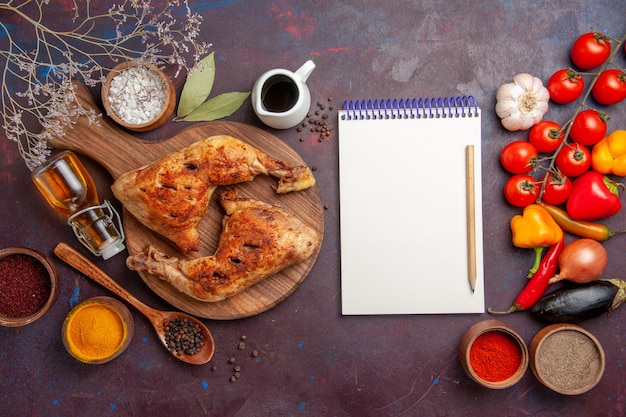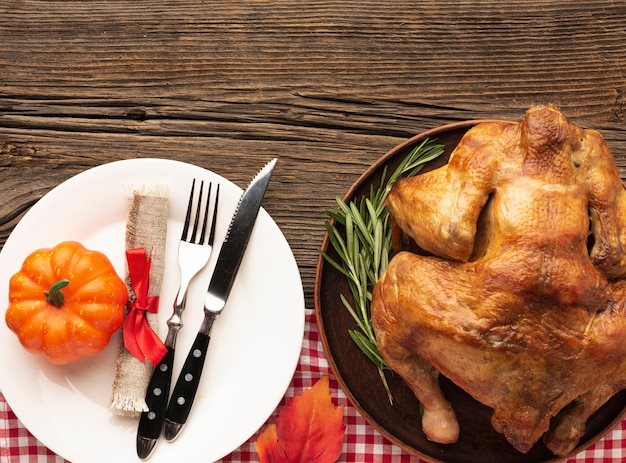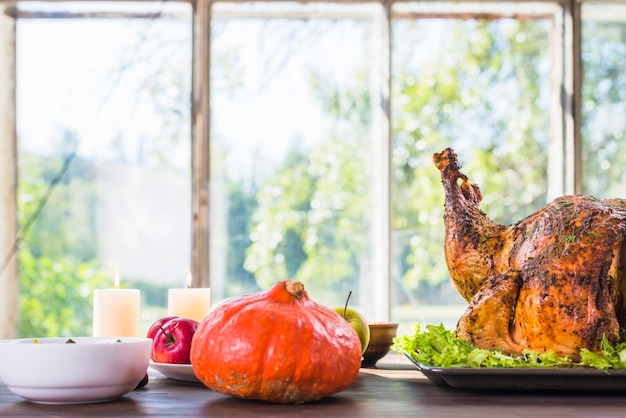Ah, the turkey. It’s the undisputed star of the festive table, the centrepiece that brings everyone together. But let’s be honest, it can be a bit intimidating. That’s why I'm here to demystify the whole turkey roasting process, from thawing to carving. I'll share my tried-and-true tips and tricks, plus some essential insights you might not have considered before. So grab a cuppa, settle in, and let's chat turkey.
(Part 1) The Basics

First things first, you're going to need a few essential items for this adventure. A sturdy roasting pan is a must - it needs to be big enough to hold your turkey without spilling all over the oven. And don't even think about skipping the meat thermometer! This is your secret weapon for ensuring a perfectly cooked bird. A good quality turkey is crucial too - don't scrimp on this, because a mediocre turkey will lead to a disappointing meal.
Unstuffing Your Turkey: A Controversial (But Wise) Choice
Now, this might cause some raised eyebrows, but trust me on this one. Stuffing your turkey after it's cooked is the way to go. I know, I know, it's tradition to stuff the bird before roasting, but let's be practical. Stuffing inside the turkey can be a breeding ground for bacteria, and nobody wants to spend Christmas battling food poisoning. Besides, stuffing cooked separately is just as delicious, if not more so. Think of it as a flavorful side dish that compliments your turkey perfectly.
The Big Reveal: Turkey cooking time Per Pound
Here's the big question: how long does it take to cook that beautiful bird? The general rule of thumb is about 15 minutes per pound at 325°F (165°C). So, a 12-pound turkey would take roughly 3 hours to cook. But hold on, there's a bit more to it than that. A few additional factors come into play, and understanding them will help you achieve that perfect, juicy turkey.
(Part 2) The Turkey Size Factor

It's tempting to think a 10-pound turkey will cook at the same rate as a 12-pound one, but that's not quite accurate. The size of your turkey has a significant impact on cooking time. Think about it: a smaller bird has less meat to cook through, so it will be done faster.
A Handy Table for Reference: Estimated Cooking Times
Here's a table to help you estimate cooking times for different turkey sizes:
| turkey weight (lbs) | Cooking Time (hours) |
|---|---|
| 8-10 | 2-2.5 |
| 10-12 | 2.5-3 |
| 12-14 | 3-3.5 |
| 14-16 | 3.5-4 |
| 16-18 | 4-4.5 |
Keep in mind that these are just estimates. It's always best to rely on your trusty meat thermometer to ensure your turkey is perfectly cooked, which leads us to our next point.
(Part 3) The Importance of a Meat Thermometer

Let me tell you, a meat thermometer is your culinary superhero when it comes to roasting a turkey. It's the only way to guarantee your turkey is cooked through and safe to eat. No ifs, ands, or buts. You wouldn't want to take any chances, especially when it comes to poultry.
Don't Trust the “Pop-Up” Thermometer
And while we're on the topic, let's address those pop-up thermometers that sometimes come with turkeys. Personally, I'm not a fan. They can be unreliable, and I like my turkey cooked perfectly every time. A proper meat thermometer will give you a precise reading, ensuring your turkey is cooked to the right temperature.
The Golden Standard: 165°F (74°C)
The recommended internal temperature for a turkey is 165°F (74°C). Insert your thermometer into the thickest part of the thigh, making sure it doesn't touch any bone. Once that thermometer hits 165°F, your turkey is ready for its star turn on the table.
(Part 4) The Resting Period: Patience is a Virtue
Now, resist the urge to carve into your turkey right after you pull it out of the oven. It needs a good rest, about 30 minutes or so. This allows the juices to redistribute evenly throughout the turkey, resulting in a juicier, more flavorful bird. Trust me, that extra wait is worth it, I promise!
Cover Your Turkey Like a Blanket: Keeping it Warm and Moist
To keep your turkey cozy and moist while it rests, cover it loosely with foil. Imagine you're wrapping your turkey in a warm, snuggly blanket – that's the idea. It'll stay warm and juicy while those flavorful juices settle back in.
The Waiting Game: Putting those 30 Minutes to Good Use
Okay, I get it, the anticipation can be a killer. But those 30 minutes will fly by, and you'll be glad you waited. Use that time to add those finishing touches to your side dishes, pour a glass of something festive, and catch up with your guests. It's a great time to relax and enjoy the anticipation of the feast ahead.
(Part 5) The “Golden Brown” Conundrum: Achieving that Perfect Crust
We all want a turkey that looks stunning, with a gorgeous golden brown crust. But here's the catch: it's not always easy to achieve without overcooking the turkey. So, how do you strike that perfect balance?
The Magic of Basting: Keeping it Moist and Crispy
Basting is your secret weapon for a beautifully browned turkey. Simply use a spoon or ladle to pour the turkey drippings over the bird every 30 minutes or so while it's roasting. This helps keep the turkey moist and develops that delicious, crispy skin we all crave.
Don’t Be Afraid to Experiment: Adding Flavor with Basting
Get creative with your basting! Instead of just using turkey drippings, you can add a bit of butter, herbs, or spices for an extra flavour boost. A little rosemary or thyme can add a touch of festive aroma. But remember, moderation is key. A little goes a long way, and you don't want to overpower the turkey's natural flavour.
(Part 6) The Breast vs. The Thigh Dilemma: A Matter of Taste
Ah, the age-old question: is the breast or the thigh the best part of the turkey? Let's be honest, it's a matter of personal preference. Some people love the juicy, succulent thigh, while others crave the leaner, more tender breast.
The Truth About Dark Meat vs. White Meat: A Tale of Fat and Flavor
Dark meat, like the thighs and legs, tends to be more flavorful because it contains more fat. White meat, like the breast, is leaner and often cooks more quickly. So, it ultimately comes down to your individual taste buds. But hey, who says you can't have both?
(Part 7) cooking a turkey for a Smaller Gathering: A Different Approach
Let's say you're hosting a smaller get-together this year, and a smaller turkey will do the trick. You might think cooking a smaller turkey is a breeze. Think again! It can actually be a bit trickier than cooking a larger bird.
The Challenges of Smaller Birds: Preventing Dryness
Smaller turkeys tend to dry out more easily than their larger counterparts. They have a smaller ratio of meat to skin, so they lose moisture faster. This means you need to pay extra attention and ensure they don't overcook.
The Importance of roasting time: Finding the Sweet Spot
The cooking time for a smaller turkey will be significantly shorter than for a larger one. Don't be tempted to rush the process. Give the smaller bird enough time to cook through, but keep a close eye on it. You might also want to slightly reduce the oven temperature to help prevent it from drying out.
(Part 8) The Turkey Thaw Dilemma: Getting it Right
You've got your turkey, you're ready to go, but oh no, it's still frozen solid. Now what? Thawing a turkey is a crucial step, and it's important to do it safely and correctly. Never thaw a turkey at room temperature – this can encourage bacteria growth.
The Best Way to Thaw a Turkey: Refrigerator Refresher
The safest and most effective way to thaw a turkey is in the refrigerator. Plan ahead and allow plenty of time. A general rule of thumb is to thaw a turkey in the refrigerator for 24 hours for every 5 pounds. So, a 10-pound turkey would need about 48 hours to thaw completely.
Other Thawing Methods: Cold Water and Microwave
There are other methods for thawing a turkey, like using cold water or a microwave. However, it's essential to follow the instructions carefully. These methods can be more time-sensitive and may require you to monitor the thawing process more closely. Remember, the refrigerator is the most reliable and safest option.
(Part 9) The Turkey Leftover Symphony: Turning Leftovers into Treats
Your turkey is cooked to perfection, you've enjoyed every last bite, and now you're left with a mountain of leftovers. Don't despair! Leftover turkey is a delicious and versatile ingredient that can be transformed into a whole range of dishes.
Turning Leftovers into Treats: Endless Possibilities
From classic turkey sandwiches and salads to hearty turkey soup and savory pies, there are countless ways to put leftover turkey to good use. It's a fantastic way to stretch your budget and add variety to your meals. Plus, a turkey sandwich the day after Christmas is a true comfort food, isn't it?
A Word of Caution: food safety First
Remember to refrigerate your leftover turkey promptly and use it within 3-4 days. Never let it sit out at room temperature for longer than two hours. Food safety is paramount, so follow those guidelines to keep your leftovers safe and delicious.
FAQs
Q: How long does it take to cook a turkey at 350°F?
The general rule of thumb for cooking a turkey at 350°F is 13 minutes per pound. However, it's crucial to check the internal temperature with a meat thermometer to ensure it's cooked through. Don't rely solely on time alone!
Q: What if my turkey is stuffed?
If you choose to stuff your turkey, it's essential to cook it to an internal temperature of 165°F in the stuffing. The stuffing will take longer to cook than the turkey itself, so be sure to check the temperature in the thickest part of the stuffing.
Q: How do I know if my turkey is done?
The most reliable way to determine if your turkey is cooked through is to use a meat thermometer. Insert it into the thickest part of the thigh, making sure it doesn't touch any bone. The turkey is cooked through when it reaches 165°F. You can also check the breast, which should reach 165°F as well.
Q: How do I keep my turkey moist?
Basting is a great way to keep your turkey moist. You can also try using a turkey roasting bag, which helps trap in moisture and prevent the turkey from drying out.
Q: What do I do if my turkey is overcooked?
Let's be honest, nobody wants to face an overcooked turkey. The meat will be dry and tough. But don't worry, you can still salvage the situation. Try shredding the turkey and using it in dishes like soup, stew, or sandwiches. It's a great way to make the most of your overcooked bird.
Everyone is watching

Corn on the Cob: The Ultimate Guide to Perfectly Cooked Ears
Healthy MealsAh, corn on the cob. Just the name evokes images of sunny days, barbecues, and that sweet, juicy flavour that ...

Perfect Pork Roast Oven Cooking Time: A Guide to Delicious Results
Healthy MealsThere's something truly satisfying about a perfectly roasted pork. The aroma alone is enough to make your mout...

Ham Cooking Time: How Long to Bake, Smoke, or Boil a Delicious Ham
Healthy MealsAh, ham. It's a classic, isn't it? A real crowd-pleaser, especially around holidays. And when done right, it'...

Scallops: The Ultimate Guide to Perfect Cooking
Healthy MealsAh, scallops. Those delicate, sweet, and utterly delicious morsels of the sea. They hold a special place in my...

Spaghetti Squash: The Ultimate Guide to Cooking and Serving
Healthy MealsRemember that time you saw spaghetti squash at the supermarket, looking all bumpy and strange, and thought, "W...
